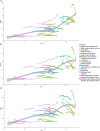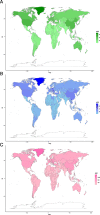Epidemiological trends of tracheal, bronchus, and lung cancer at the global, regional, and national levels: a population-based study
- PMID: 32690044
- PMCID: PMC7370495
- DOI: 10.1186/s13045-020-00915-0
Epidemiological trends of tracheal, bronchus, and lung cancer at the global, regional, and national levels: a population-based study
Abstract
Background: Investigations of disease incidence, mortality, and disability-adjusted life years (DALYs) are valuable for facilitating preventive measures and health resource planning. We examined the tracheal, bronchus, and lung (TBL) cancer burdens worldwide according to sex, age, and social development index (SDI) at the global, regional, and national levels.
Methods: We assessed the TBL cancer burden using data from the Global Burden of Disease (GBD) database, including 21 regions, 195 countries, and territories in the diagnostic period 1990-2017. The data of TBL cancer-related mortality and DALYs attributable to all known risk factors were also analyzed. Age-standardized rates (ASRs) and their estimated annual percentage changes (EAPCs) were calculated.
Results: Incident cases, deaths, and DALYs of TBL cancer increased worldwide (100.44%, 82.30%, and 61.27%, respectively). The age-standardized incidence rate (ASIR) was stable (EAPC = 0.02, 95% confidence interval [CI] - 0.03 to 0.08), but the age-standardized death (EAPC = - 0.34, 95%CI - 0.38 to - 0.3) and DALY rate decreased generally (EAPC = - 0.74, 95%CI - 0.8 to - 0.68). However, the change trend of ASIR and ASDR among sexes was on the contrary. China and the USA always had the highest incidence, mortality, and DALYs of TBL cancer. Significant positive correlations between ASRs and SDI were observed, especially among females. High (36.86%), high-middle (28.78%), and middle SDI quintiles (24.91%) carried the majority burden of TBL cancer. Tobacco remained the top cause of TBL cancer death and DALYs, followed by air pollution, the leading cause in the low-middle and low-SDI quintiles. Metabolic risk-related TBL cancer mortality and DALYs among females increased but was stable among males. The main ages of TBL cancer onset and death were > 50 years, and the DALYs concentrated in 50 - 69 years.
Conclusions: To significantly reduce the growing burden of TBL cancer, treatment resources need to be skewed according to factors such as risks and geography, especially for high-risk groups and high-burden areas. Asia had the greatest TBL cancer burden, followed by high-income North America. Tobacco remains the leading cause of death and DALYs, followed by air pollution. Effective prevention measures against tobacco and air pollution should be strengthened.
Keywords: Death; Disability-adjusted life years; Global burden of disease; Incidence; Tracheal, bronchus, and lung cancer.
Conflict of interest statement
The authors declare that they have no competing interests.
Figures






References
-
- Lorenzo-Gonzalez M, Ruano-Ravina A, Torres-Duran M, Provencio-Pulla M, Kelsey K, Parente-Lamelas I, et al. Lung cancer risk and do-it-yourself activities. A neglected risk factor for lung cancer. Environ Res. 2019;179(Pt B):108812. - PubMed
-
- Hirsch FR, Scagliotti GV, Mulshine JL, Kwon R, Curran WJ, Jr, Wu YL, et al. Lung cancer: current therapies and new targeted treatments. Lancet (London, England) 2017;389(10066):299–311. - PubMed
-
- Barnett R. Lung cancer. Lancet (London, England) 2017;390(10098):928. - PubMed
MeSH terms
LinkOut - more resources
Full Text Sources
Medical

